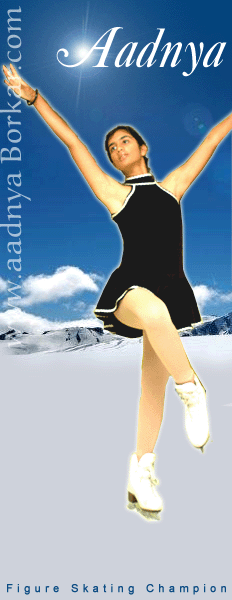Ice
skating is the act of gliding over a smooth
surface of ice on ice skates--boots with attached
metal blades. For hundreds of years, people
could ice-skate only during the winter months
in cold climates. They skated on natural ice
surfaces such as frozen canals, lakes, ponds
and rivers. Today, machines produce ice in indoor
rinks, making ice skating a form of recreation
that can be enjoyed throughout the year.
People
of almost any age can enjoy ice skating as healthful
and relaxing exercise. Skaters use most of the
body’s muscles, especially the muscles.
Skating helps blood circulation by strengthening
the heart.
Ice
skating is an important competitive sport as
well as popular form of recreation. Athletes
complete in two kinds of ice skating –
figure skating and speed skating. Figure skaters
perform leaps, spins and other graceful movements,
usually to music. Speed-skaters compete in races
of various distances. Many young people and
adults also play hockey, a fast, rugged sport
in which the players wear ice skates. Millions
of people attend ice shows each year. Ice shows
are colourful spectacles that often feature
champion figure-skaters.
Figure-skating
competitions are held on a rink about 200 feet
(60 meters) long and 100 feet (30 meters) wide.
The rink has gently rounded corners and is surrounded
by a barrier about 4 feet (1.2 meters) high.
Figure
skates have a special blade that enables competitors
to perform the difficult moves required in figure
skating. The blade is 1/8 inch (3 millimeters)
thick and about 12 inches (30 centimeters) long.
The blade has an inside and outside edge. Skaters
skate on one edge at a time. The bottom of the
blade is slightly curved inward. This curve
permits only a small part of the blade to touch
the ice at one time, enabling a skater to maneuver
more easily. The front of the blade has several
teeth called toe picks. Skaters use the toe
picks to bite into the ice when performing certain
jumps and spins. The boots of figure skates
have a high top.
Figure-skaters
wear costumes that are comfortable and attractive
and that permit freedom of movement. Women generally
wear a simple dress with a short skirt and matching
tights. The men usually wear close-fitting,
comfortable pants with a matching shirt.
Figure-skaters
may take part in (1) single skating, (2) pair
skating, (3) ice dancing, and (4) precision
skating. Men and women compete separately in
singles skating, but they follow similar rules.
In pair skating and ice dancing, teams consisting
of a man and a woman compete against one another.
Precision skating involves groups of 12 to about
24 skaters each that compete as teams. The teams
try to perform as a single unit rather than
as soloists.
Figure
skaters compete at various levels, depending
on their skill. Skaters must pass proficiency
tests to advance to a higher level. The highest
level is the senior level.
Judges
score all events on a scale of 0 to 6 points,
with 6 being the highest score. They carry the
skater’s scores to one decimal place,
as in a score of 3.7.
Singles
skating consists of two parts in both
men’s and women’s competition. They
are the short program and the free-skating program,
also known as the long program.
The
short program counts one-third of the skater’s
total score for the competition. It consists
of eight required move or elements : three jumps,
three spins and two fast step sequences or footwork.
All skaters perform the same moves. The moves
may be done in any sequence with a 2 minute
40 second time limit. The moves are performed
to music selected by the skater.
Each
skater receives two scores. The first score
reflects the technical merit of the skater’s
program--that is, how accurately the skater
performed the moves. The second score reflects
the program’s artistic impression, which
evaluates the overall program, including its
choreography, artistry and expression.
The
free-skating program accounts for two-thirds
of the skater’s score. Free skating has
no required elements and has a length limitation
of 4 minutes for women and 4½ minutes
for men. In free skating, the skaters select
their own music and theme, and choreograph many
difficult spins, jumps, footwork and interpretive
moves to best display their technical and artistic
skills. As in the short program, scores are
given for technical merit and for artistic impression.
Compulsory
figures were originally part of Olympic and
other international competitions. Compulsory
figures are now required only at the basic levels
of figure skating in the United States and they
are a separate, optional event for senior skaters.
Compulsory figures are intended to demonstrate
a skater’s skill in mastering total control
of motion, speed, balance and edges. Each figure
consists of two or three circles that form a
variation of the figure “8”. Skaters
must create and then trace circles that are
perfectly shaped and of the same size as the
originals.
